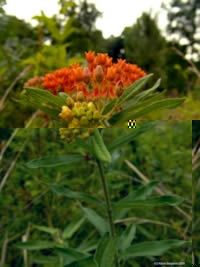
Butterfly Weed Herb
Asclepias tuberosa
Other Names: Butterfly Milkweed, Chiggerflower, Milkweed, Pleurisy Root, Tuberous Swallowwort, Orange Swallow-wort, Yanagi-Towata
Photos by Karen Bergeron, Karen Shelton (c) 2002 - 2015
Butterflyweed Herbal Uses
Also known as Pleurisy Root, Butterfly Weed is an edible plant that is used by herbalists.
Pleurisy root is used in herbalism as an antispasmodic, carminative, mildly cathartic, diaphoretic, diuretic, expectorant, tonic and vasodilator. Butterfly Weed Root is used internally in the treatment of diarrhea, dysentery, chronic rheumatism, and as an expectorant. It it said to be a valuable herb in all chest complaints and in the treatment of many lung diseases. A herbal poultice of the roots is used in the treatment of swellings, bruises, wounds, and skin ulcers.
Caution is advised, as large doses of Butterfly Weed are emetic and purgative.
Butterflyweed Edible Uses
The seed pods are edible, cooked when young, harvest them before the seed floss forms. Harvest flowers in bloom, also edible cooked, said to taste like sweet peas. Leaves and new buds are edible cooked like spinach. Harvest root in fall and dry for later herb use.
Other uses
The above ground parts of Butterfly weed are used mainly for food and clothing. The bark is used to make a quality fiber and woven into twine or cloth. The seed floss is used for stuffing in pillows and life jackets, candle wicks, and fibers to make cloth. Research indicates the floss is effective at cleaning up oil spills at sea.
Butterfly weed Description and Habitat
Butterfly weed is a perennial herb native to North America from Southern Ontario and New York, to Minnesota, south to Florida and Colorado. It grows in dry open fields, along roadsides and grassy places. Butterfly weed root is spindle-shaped, large, branching, white, and fleshy with a knotted crown, it sends up several erect, stout, round and hairy stems, growing from 1 to 3 feet high. Stems are branched near the top and have corymbs or umbels of many deep yellow to dark orange, or almost red, flowers. The leaves grow closely all the way up the stem and are hairy, unserrated, lance shaped, alternate, sessile and dark green on top, lighter beneath.
Butterfly weed flowers bloom from June to September, followed in the fall by seed pods from 4 to 5 inches long, containing the seeds with their long silky hairs or floss. This plant, unlike the other milkweeds, contains little or no milky juice.
How to Grow Butterfly Weed
Cultivation: Butterfly Weed is easy, can be transplanted in fall or grown from seed, prefers a well-drained light, sandy, humus rich, or peaty soil in a sunny position.
Butterfly weed History and Folklore
Some Native American legends tell of the roots being used as a body wash for lifting and running strength. Also used as a drug in chant lotion, and as a ceremonial emetic. A ceremony is connected with the obtaining and distribution of this highly valued root.
Butterfly weed Herbal Recipe
Infusion To 1 tsp. of the powdered or fresh smashed root add 1 cup of boiling water, steep 10 to 20 min. take warm at bedtime. In cases of lung congestion take this mixture in half cup doses 4 to 6 times a day.
Article by Deb Jackson & Karen Bergeron



